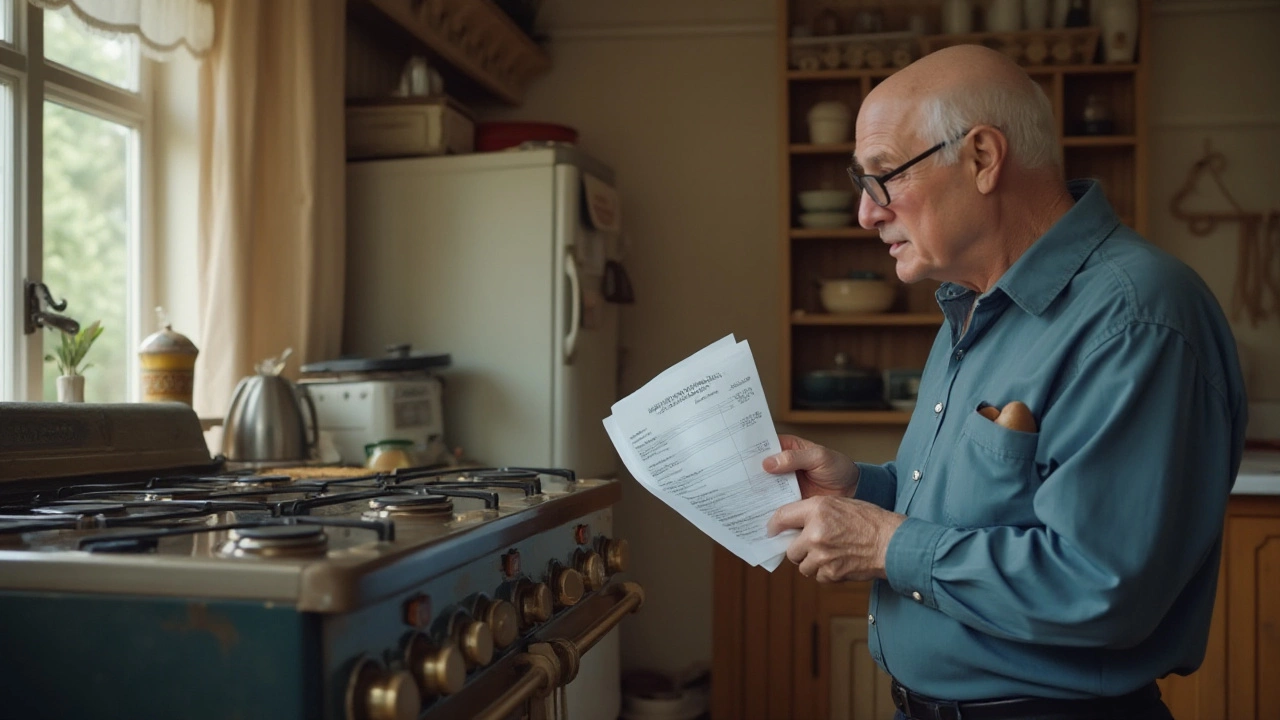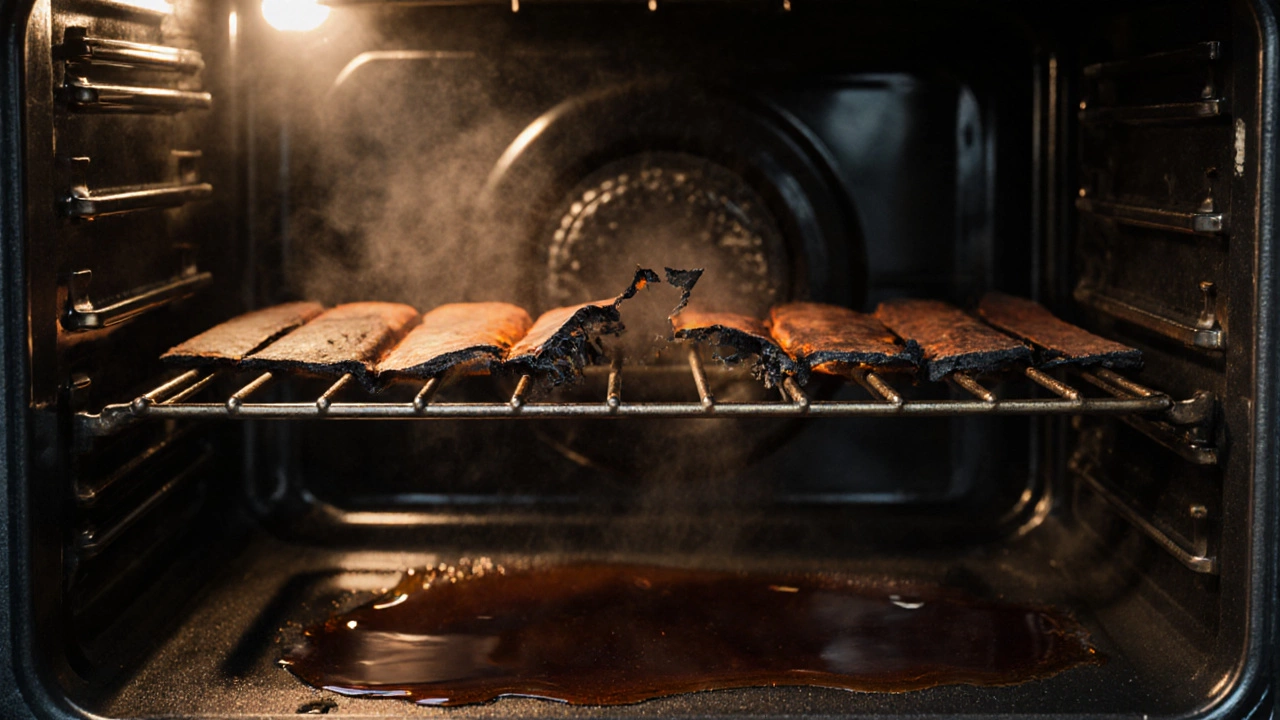
- 20 Apr 2025
- Gideon Thornton
- 0
Ever pulled a pizza out of the oven only to find one side charred and the other still cold? That's not just bad luck—it's a big red flag your oven might need to go. Most people don't really think about their ovens until dinner shows up burnt or raw. But the truth is, an electric oven gives you plenty of hints before it kicks the bucket for good.
If your oven takes forever to heat up or can't keep a steady temperature, that's a sign the heating element is struggling. Burners that spark, click, or just stop turning on usually mean something is seriously wrong. And don't ignore weird smells—if your kitchen smells like burning plastic or metal, that's not normal, and it can point to wiring going bad. Even noises like buzzing, popping, or rattling often mean the end is near. Ovens are supposed to be quiet background players, not the stars of a horror movie.
- Obvious Signs Your Oven Is Failing
- When a Repair Won't Cut It
- Choosing a New Oven (the Smart Way)
- FAQs and Pro Tips
Obvious Signs Your Oven Is Failing
Your electric oven shouldn't turn cooking into a guessing game. When things start going sideways, most ovens send up some clear distress signals. The trick is spotting them before you end up with a ruined dinner and a bigger hole in your wallet.
One of the biggest red flags is uneven cooking. If your cookies are burnt on one side and gooey on the other, that's a sign the heating elements aren't working right. A weak or dying element can cause hot and cool spots across your oven rack. According to the Association of Home Appliance Manufacturers, most heating elements should last around five years, but heavy use can kill them much sooner.
- Frequent undercooked or overcooked food, even on the same temperature setting.
- Weird noises like popping, buzzing, or clicking inside the oven. Ovens aren't supposed to sound like old lawnmowers.
- Lights or digital displays that won’t turn on—or flicker and go dark. That usually means electrical problems, which aren’t something you want to ignore.
- Consistent smells of burning plastic or metal. This is a big safety risk, not just an annoyance.
- Visible rust, cracks, or warped parts inside the oven. These aren’t just ugly—they mean your oven might not be safe anymore.
| Common Sign | What It Might Mean |
|---|---|
| Uneven heating | Broken heating element or bad thermostat |
| Delay in preheating | Failing main electrical parts |
| Door won’t seal | Damaged hinges or worn gasket |
If you find yourself reaching for the kitchen timer more because you can't trust your oven's heat, it's time to think about repair or replacement. As appliance expert Daniel Wroclawski at Consumer Reports puts it:
"An oven that can’t hold temperature or has electrical glitches is more than just a headache—it's a hazard that’s only going to get worse."
So, if you’re picking up on any of these signs, don’t shrug them off. Catching the problem early could save you from an even bigger mess down the line, especially when it comes to oven repair or deciding when it's finally time to go for an oven replacement.
When a Repair Won't Cut It
Trying to fix an old electric oven can feel like throwing money into a bottomless pit. So when do DIY tricks and even professional repairs just stop making sense? If your repair bill is creeping close to half the price of a new oven, it's already time to start shopping.
Here's what pushes your oven repair into "lost cause" territory:
- Major electrical issues – If your oven trips breakers, sparks, or the digital controls glitch or die, you’re probably facing expensive repairs and safety risks.
- Broken heating elements – Replacing both the broil and bake elements in one go isn’t cheap, and if they fail again, you could be stuck in a loop.
- Insulation or structural damage – If heat escapes, hinges refuse to close, or you spot warped metal, repairs won’t restore things to normal. Energy bills start creeping up, too.
- Obsolete parts – If the tech says the part’s discontinued or on backorder for months, you’re probably out of luck—or stuck with a Frankenstein fix that barely holds up.
- Age over 15 years – Most kitchen appliances like electric ovens last about 10-15 years. Anything past that is basically living on borrowed time.
Check out what you might spend just keeping an old oven running versus getting a new one:
| Common Repair | Typical Cost (USD) |
|---|---|
| Heating element | $150 - $300 |
| Control board replacement | $200 - $400 |
| Sensor issues | $100 - $200 |
| Door repairs | $100 - $250 |
Sometimes, you’ll spot companies running sales on new models for $500–$800, which makes spending $400 on band-aid repairs a tough sell.
Another thing: safety. If an oven overheats, leaks electricity, or melts wiring, you’re not just wasting cash—you’re literally taking risks in your own home. Appliances don’t get safer with age. So if the problems sound like more than just a fuse or a knob, it’s almost always smarter to replace, not repair.

Choosing a New Oven (the Smart Way)
If your old electric oven is toast, picking a new one can actually save you money and hassle down the line. Don’t just go for the first shiny model. The right oven isn’t always the fanciest — it’s the one that fits your space, how you cook, and your electric bill.
- Size matters. Measure your cut-out space. Sticking with the same dimensions saves stress with installation. A standard oven is about 30 inches wide, but check the height and depth, too. Nobody wants a return trip to the store.
- Convection or not? Convection ovens use fans to blow hot air and cook food more evenly. For folks who bake a lot or love crispy pizza crust, convection is worth the little extra cost.
- Self-cleaning features are awesome. A good self-clean mode saves hours scrubbing baked-on gunk. Most electric ovens with this option only cost about $100 more, and it's money well spent if you hate scrubbing as much as I do.
- Settings and controls. Touchscreens look futuristic, but if you hate fingerprints, consider simple knobs. Also, check if the oven holds steady at your typical cooking temps—some budget models run hot or cold.
- Energy efficiency. A new electric oven with an Energy Star rating can use up to 20% less energy. Over five years, that could save you more than $100, which is basically a month of groceries (if you shop like I do).
| Appliance | Average Lifespan (Years) |
|---|---|
| Electric Oven | 13-15 |
| Dishwasher | 9-12 |
| Refrigerator | 12-14 |
Brands like GE, Whirlpool, and KitchenAid are usually reliable. It’s not just about the name, though—it’s about availability of parts if something breaks down in a few years. Check reviews and look for warranties. If your budget is tight, hunting for last year’s models can save a chunk without missing useful features.
One underrated tip? Open the oven door and fiddle with the racks in-store or when the delivery folks show up. Racks should slide easily and not feel flimsy. If it seems awkward empty, it’ll be even worse loaded with a big pan of lasagna.
And whatever you get, make sure it matches your kitchen’s power hookup. Most electric ovens need a dedicated 240-volt outlet. Don't assume—double-check before you buy so it doesn’t become a really expensive shelf.
FAQs and Pro Tips
People have tons of questions when it comes to dealing with a tricky electric oven. Here are the answers to some common ones, along with quick tips you can actually use.
- How long does a typical electric oven last?
Most electric ovens hold up for around 10-15 years. If yours is heading toward that age and repair costs are creeping up, it’s probably not worth sinking more cash into it. - Is it worth repairing or just replacing?
If your warranty is gone and repairs cost more than half the price of a new oven, replacement usually makes more sense. Plus, newer models use less energy, so you’ll save money in the long run. - Why does my oven smell like burning plastic?
Burning plastic smells can mean a wire is melting (not good). Turn off the oven, and unplug it if possible. Call a pro—don’t try to fix melting wires yourself. - My oven takes forever to heat—why?
This usually means a heating element or thermostat is failing. Sometimes you can swap those out, but if the problem keeps coming back, the whole unit might be wearing out. - How do I make my next oven last longer?
Simple: clean up spills right away, avoid using oven cleaners with harsh chemicals, and don’t block the vents. Even my cat Whiskers could tell you not to slam the oven door—broken hinges mess up the seal and ruin heat flow.
More practical tips from someone who’s wrecked an oven or two:
- Test your oven's temp with an external thermometer once a year. Ovens lie all the time.
- If your oven has a self-clean setting, don’t overuse it. The crazy high heat can wreck the electronics if you run it every month.
- Don’t ignore small sparks or weird noise from burners. Better safe than sorry.
- Before giving up, check the power source—sometimes it’s just a tripped breaker.
| Repair | Average Cost (USD) |
|---|---|
| Heating Element | $180 |
| Thermostat | $150 |
| Control Board | $300 |
| New Electric Oven | $600 - $2000 |
Bottom line? Know the warning signs and don’t keep throwing cash at an ancient kitchen appliance. A reliable oven makes life way easier—no one wants half-baked brownies or a kitchen fire.



